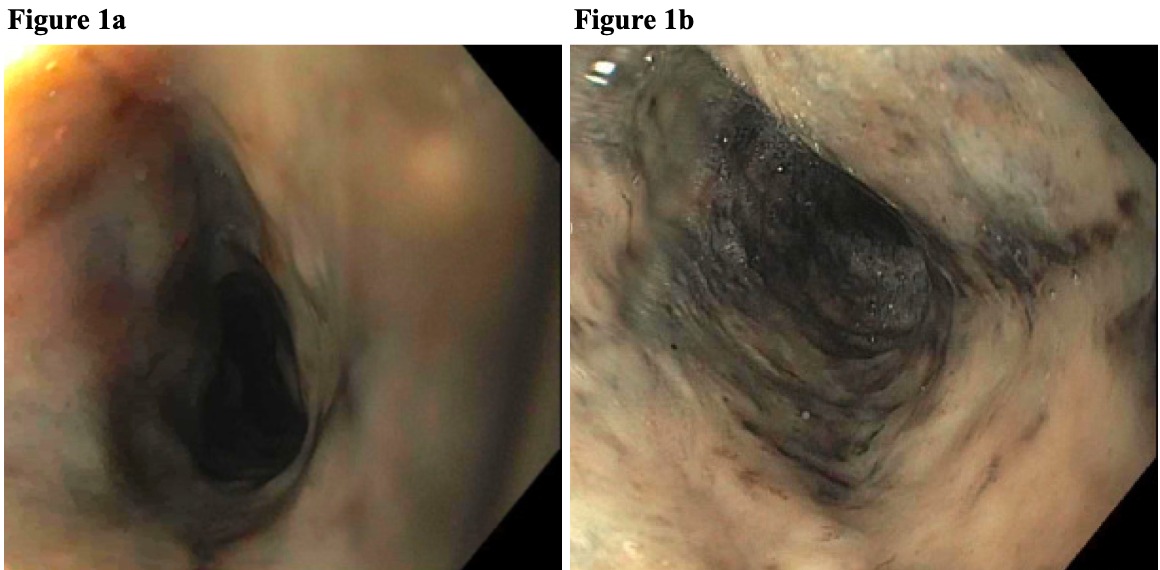Back
Poster Session E - Tuesday Afternoon
E0238 - An Esophagus as Dark as the Night: Acute Esophageal Necrosis
Tuesday, October 25, 2022
3:00 PM – 5:00 PM ET
Location: Crown Ballroom

Melissa A. Colaluca, MD
The University of Connecticut
Hartford, CT
Presenting Author(s)
Melissa A. Colaluca, MD1, Erica C. Becker, MD, MPH2, Jennifer Onwochei, MD3, Michael Einstein, MD4
1The University of Connecticut, Hartford, CT; 2University of Connecticut Health Center, Farmington, CT; 3UConn Health, Hartford, CT; 4Hartford Hospital, Hartford, CT
Introduction: In one of its most severe forms, esophagitis may present as acute esophageal necrosis (AEN), which is a condition characterized by a diffusely black esophageal mucosa on upper endoscopy. AEN is a rare disorder, with a prevalence of only 0.2%. Since the first endoscopic characterization by Goldenberg et al. (1999), the underlying pathophysiology remains elusive. This case demonstrates the more recently identified correlation between diabetic ketoacidosis (DKA) and AEN.
Case Description/Methods: A 46-year-old male with a medical history of cocaine use disorder, type 2 diabetes, and hypertension presented to our hospital with hematemesis and altered mental status. He reported no melena or hematochezia and had no prior history of endoscopic evaluation. On arrival, he was hypotensive, tachycardic, and tachypneic. Physical exam revealed diffuse abdominal tenderness. He was noted to be in DKA and urine toxicology was positive for cocaine. He was resuscitated and started on a Protonix drip. Insulin drip was also initiated per DKA protocol. Gastroenterology was consulted for coffee ground emesis and down trending hemoglobin. Upper endoscopy showed severe active esophagitis with ischemic appearing mucosa in the entire esophagus (Figure 1a and Figure 1b). Biopsies revealed severe esophagitis with ulceration and immunohistochemical testing for CMV and HSV was negative. The patient was managed medically with pantoprazole twice daily and he recovered gradually with plans to repeat EGD in 6-8 weeks to assess healing.
Discussion: AEN is an uncommon syndrome characterized by diffuse, circumferential black esophageal mucosa with an abrupt transition at the gastroesophageal junction. The underlying pathophysiology is thought to be multifactorial: tissue hypoperfusion, poor local defense barriers, and an insult to esophageal mucosa from reflux of gastric contents. Underlying clinical conditions such as diabetes mellitus, cardiovascular diseases, cirrhosis, sepsis, and renal insufficiency are likely predisposing factors.
As in the case above, there is also a strong link between DKA and AEN. Yasuda et al. (2006) described four cases of AEN in patients who initially presented with DKA. AEN diagnosis requires a high index of suspicion as it generally carries a poor prognosis with one-third of patients succumbing to their underlying illness. The goal of therapy is prompt treatment of coexisting, underlying medical diseases, adequate fluid resuscitation, hemodynamic stabilization, and nutrition.

Disclosures:
Melissa A. Colaluca, MD1, Erica C. Becker, MD, MPH2, Jennifer Onwochei, MD3, Michael Einstein, MD4. E0238 - An Esophagus as Dark as the Night: Acute Esophageal Necrosis, ACG 2022 Annual Scientific Meeting Abstracts. Charlotte, NC: American College of Gastroenterology.
1The University of Connecticut, Hartford, CT; 2University of Connecticut Health Center, Farmington, CT; 3UConn Health, Hartford, CT; 4Hartford Hospital, Hartford, CT
Introduction: In one of its most severe forms, esophagitis may present as acute esophageal necrosis (AEN), which is a condition characterized by a diffusely black esophageal mucosa on upper endoscopy. AEN is a rare disorder, with a prevalence of only 0.2%. Since the first endoscopic characterization by Goldenberg et al. (1999), the underlying pathophysiology remains elusive. This case demonstrates the more recently identified correlation between diabetic ketoacidosis (DKA) and AEN.
Case Description/Methods: A 46-year-old male with a medical history of cocaine use disorder, type 2 diabetes, and hypertension presented to our hospital with hematemesis and altered mental status. He reported no melena or hematochezia and had no prior history of endoscopic evaluation. On arrival, he was hypotensive, tachycardic, and tachypneic. Physical exam revealed diffuse abdominal tenderness. He was noted to be in DKA and urine toxicology was positive for cocaine. He was resuscitated and started on a Protonix drip. Insulin drip was also initiated per DKA protocol. Gastroenterology was consulted for coffee ground emesis and down trending hemoglobin. Upper endoscopy showed severe active esophagitis with ischemic appearing mucosa in the entire esophagus (Figure 1a and Figure 1b). Biopsies revealed severe esophagitis with ulceration and immunohistochemical testing for CMV and HSV was negative. The patient was managed medically with pantoprazole twice daily and he recovered gradually with plans to repeat EGD in 6-8 weeks to assess healing.
Discussion: AEN is an uncommon syndrome characterized by diffuse, circumferential black esophageal mucosa with an abrupt transition at the gastroesophageal junction. The underlying pathophysiology is thought to be multifactorial: tissue hypoperfusion, poor local defense barriers, and an insult to esophageal mucosa from reflux of gastric contents. Underlying clinical conditions such as diabetes mellitus, cardiovascular diseases, cirrhosis, sepsis, and renal insufficiency are likely predisposing factors.
As in the case above, there is also a strong link between DKA and AEN. Yasuda et al. (2006) described four cases of AEN in patients who initially presented with DKA. AEN diagnosis requires a high index of suspicion as it generally carries a poor prognosis with one-third of patients succumbing to their underlying illness. The goal of therapy is prompt treatment of coexisting, underlying medical diseases, adequate fluid resuscitation, hemodynamic stabilization, and nutrition.

Figure: Figure 1a: Circumferential necrosis in the upper third of the esophagus.
Figure 1b: Circumferential necrosis in the middle third of the esophagus.
Figure 1b: Circumferential necrosis in the middle third of the esophagus.
Disclosures:
Melissa Colaluca indicated no relevant financial relationships.
Erica Becker indicated no relevant financial relationships.
Jennifer Onwochei indicated no relevant financial relationships.
Michael Einstein indicated no relevant financial relationships.
Melissa A. Colaluca, MD1, Erica C. Becker, MD, MPH2, Jennifer Onwochei, MD3, Michael Einstein, MD4. E0238 - An Esophagus as Dark as the Night: Acute Esophageal Necrosis, ACG 2022 Annual Scientific Meeting Abstracts. Charlotte, NC: American College of Gastroenterology.

